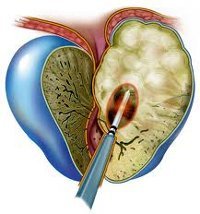Prostatitis-acute – infectious and inflammatory to the defeat of the prostate gland, accompanied by swelling and the formation of septic injuries in the tissues of the prostate. The manifestations of prostatitis acute depends on the stage (fever, catarrhal, follicular, parenchymatous, abscessed) and may include dysuric disorders, pain in the perineum, fever, intoxication. The diagnosis is based on palpation of the prostate, ULTRASOUND and Doppler studium of the prostate, of the search for a lesion of the urethra and the secret of the prostate. The treatment of prostatitis acute includes the assignment of an antimicrobial therapy, NSAIDS, anti-spasmodics, analgesics, immunomodulators, physiotherapy.

Acute and chronic prostatitis are the most common social and male diseases. In the clinic of urology of the prostate are diagnosed in 30-58% of men who are in childbearing age and of working age (30-50 years). During prostatitis acute accompanied by disorders of the sexual function and fertility, disorders of psychoemotional state and social disadaptation.
The reasons of prostatitis acute
Agents of prostatitis acute mainly act as non-specific infectious agents to penetrate into the tissue of the prostate - gram-negative (escherichia coli, klebsiella, proteus) or gram-positive (staphylococci, enterococci, streptococci)
Often, the prostatitis acute, can be caused by agents urogenitalnih infections:
- chlamydia infection,
- trichomoniasis,
- ureaplasma,
- gonorrhea,
- mycoplasmosis,
- candidiasis and al
The more often the penetration of antimicrobial agents into the tissue of the prostate transcanalicular in – emissaries through the channels of the gland, the opening in the rear wall of the urethra. Therefore, urethritis all of genesis is very often complicated by acute prostatitis. Less of the microbial flora enters the prostate of the bladder during acute cystitis. The introduction of pathogens in the gland is much easier when it is intraurethral pressure (reprehenderat, the stones of the urethra), keeping the endourethral manipulations (bougienage of the urethra, bladder catheterization, ureteroscopy, cystoscopy, etc).
In addition, the prostatitis acute may be the result of a hematogenous infection, fuelled by the conditions of the vasculature of the prostate developed in the arterial system and venous anastomoses. When hematogenous snow microbes that can penetrate into the prostate tissue away from septic injuries during tonsillitis, sinusitis, caries, cholecystitis, bronchitis, pyodermite and others May be lymphogenous infection of the prostate from the bowel when the anal fissures, proctitis, colitis.

Non-communicable diseases factors that contribute to the development of prostatitis acute, persistent stagnation in the veins of the pelvis and the violation of drainage acinus of the prostate. The stagnation can be disritmia the sexual life and the sexual problems – sexual intercourse, lack or are not regular sexual life excessive sexual activity, and other Pathological deposition of blood in the course of a woman's pelvic floor can be at a sedentary lifestyle, frequent constipation, colds, chronic (especially alcohol) poisoning, varicose veins of the pelvis.
Form of prostatitis acute
In the development of prostatitis acute secrete the following forms, which are both different stages:
- fever, bluetongue,
- follicular,
- parenchymal,
- abscess.
Prostatitis acute begins with a catarrhal inflammation of the changes in mucosal and submucosal layer of the examples of ducts of individual lobules of the gland. In the following, a swelling of the wall of the duct contributes to the stagnation of muco-purulent secretions in the follicles of the prostate and progression of inflammation, in addition to developing uneven suppuration chicken spicy follicular prostatitis. When the plural defeat of the lobules, and diffuse involvement parenchymal and the interstitial tissue of the prostate in gnojno-an inflammatory process, prostatitis, acute as it enters its second phase – parenchymal. In the case of a merger of small ulcers in the grand foyer is formed in an abscess of the prostate may open into the urethra, the perineum, the rectum or the bladder.
The symptoms of prostatitis
The clinical manifestations during of prostatitis acute correspond to the process steps. Common manifestations are pain, disorders of urination and intoxication.
In acute catarrhal stage of prostatitis feel the heaviness and pain in the perineum. Dysuric disorder is characterized by the painful contact information urinate, especially at night. The temperature of the body is stored within the limits of the normal, may be slightly higher; the intoxication is absent. During the palpation examination of the prostate has not changed or has slightly increased, some painful. The search for the secret of the prostate detects an increase of the leukocytes, congestion of the muco-purulent son. In the urine when emptying examples of ducts acinus appear leukocytes. The prostate massage is usually impossible because of the pain. The treatment started in the phase of prostatitis acute, leads to the healing of 7-10 days.
Follicular form of prostatitis acute is more lively, accompanied obtuse aching pain in the perineum, irradiating in the penis, anus, or the sacrum. In this context, the urination painful and difficult, until the development of the acute retention of urine. The act of defecation in the follicular prostatitis is also difficult to explicit cause of the pain. Given the increase of body temperature up to 38°With deterioration of the general condition. Palpation per rectum is determined increased, dense, intense, asymmetrical, prostate, strongly painful in some parts when Paltseva study. The urine is collected after the palpation of the gland, contains a large number of leukocytes and purulent filaments forming the disorder in the sediment. The required massage to get the secret of the prostate gland in the follicular stage of prostatitis acute is contraindicated. When aggressive treatment of acute follicular prostatitis may favorably resolve; in the contrary case, it proceeds to the next, parenchymal the stage.

The clinical acute parenchymatous prostatitis develops rapidly. Characteristic expressed hyperthermia (up to 39-39,5°c and above) with chills, weakness, total, inhibition of appetite, thirst. First urination strongly acclre and hard, and then may stop entirely. The attempts of the emptying of the bladder or of the intestine are accompanied by intense pain. Develop intensely tenesmus, constipation, flatulence. The pain spreads to the rectum, has a character-pulsatile, requires the patient to take distress – coated with pinches the feet. During the development of a reactive inflammation of the rectum from the anus of mucus.
Palpation defined, diffusely increased, with blurs the contours of iron, it is extremely painful to the slightest touch. The prostate massage in parenchymal stage of prostatitis acute is strictly contraindicated. Sometimes, due to the strong swelling pararectal of fiber and the pain the digital rectal exam are not able to proceed. In the urine, the strongly marked of the album sanguinem cellam, pyuria. Result acute parenchymatous prostatitis can be used in the resolution of the disease, the formation of an abscess of the prostate or chronic prostatitis.
The diagnosis of prostatitis acute
The recognition and definition of the stage of prostatitis acute is performed by the urologist, and is based on a physical examination, laboratory and toolkit of the survey. The study of the prostate through the rectum used to determine the size, consistency, homogeneity, symmetry of the breast; painful of the reaction, the pockets of deterioration, the signs of the fusion surgery purulent tissue. Palpation of the prostate for prostatitis and acute is done very gently, without serious pressure and massaging movements. In the secret of the prostate is detected an increase in the number of leucocytes and amyloid taurus, the reduction in the number of the lecithin grains.
When the prostatitis is acute high leykotsituriya in the third part of the urine and the urine collected after the palpation of the prostate. For the selection of the pathogen of prostatitis acute, it will be necessary to organize the bacterial inoculation test of urine and a lesion of the urethra with antibiotics, PCR-research from scratch, planting the seed of blood on sanguinem cultura. The nature and severity of the dysuric disorders in prostatitis acute is evaluated using uroflowmetries.

ULTRASOUND of the prostate moderate pain syndrome can be performed transrectal; in the case expressed the reaction – transabdominal. Anoscopically estimated of the form, the value of the gland, focal or diffuse changes, has been installed on the stage of prostatitis acute. The use of the Doppler studium allows a detailed and differentiated to assess vascularization of the prostate.
When planning the tactical surgical with respect to the forms of prostatitis acute advised to the realization of a ct scan or MRI pelvic.
Treatment of prostatitis acute
The main role in the treatment of prostatitis belongs etiotropnoy of the therapy. Required as soon as possible the appointment of antimicrobial (antibacterial, antiviral drugs, antitrichomonal, antimycotic) drugs to stop the reproduction of micro-organisms in the iron and the tissue of the urethra. In order to reduce spasms and pain in urination, prescribed analgesic, antispasmodic, candles with Anaesthesinum or belladonna, of the heat microclystères. In the treatment of prostatitis acute used NSAIDS, enzymes, immunomodulators, vitamins, infusion of solutes.
Physiotherapy treatment for prostatitis and acute is performed after decrease in symptoms of acute. For the anti-inflammatory, anti-edematous, analgesic action, improving the microcirculation and local immunity apply rectal electrophoresis, UHF-therapy, MICROWAVE therapy, prostate massage. When the prostatitis acute shows respect to the plan, a diet, of sexual rest.
In the event of a delay of urine on the background of prostatitis, acute avoid catheterization of the urinary bladder, preferably trocar cystostomy. When the abstsedirovanie prostate cancer, the need for surgical from the allocation of the dissection and drainage of the cavity of the abscess.
On the cure of prostatitis acute is judged by the recovery of the tissue structure of the thyroid gland and its functions, the normalization of the composition of the juice of the prostate, the elimination of the pathogens that cause inflammation of body fluids.
Prediction and prevention
Typically, in a timely and reasonable a causal treatment leads to cupping, signs of prostatitis acute. The formation of abscesses in the prostate or chronic inflammation occurs in advanced cases.
The prevention of prostatitis acute needs include sanitation infective foci in the body, the holding of endovesical and endourethral handle in accordance with the standards of asepsis, the time of treatment of STDS and urethritis, the normalization of the sexual life and physical activity.
























